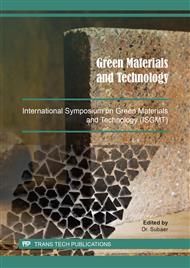[1]
Bawalan, D. D., & Chapman, K. R. (2006). Virgin coconut oil production manual for micro- and village-scale processing. Bangkok: Food and Agriculture Organization Regional Office for Asia and the Pacific.
Google Scholar
[2]
Mansor, T. S. T., Che Man, Y. B., Shuhaimi, M., Afiq, M. J. A., & Nurul, F. K. M. (2012). Physicochemical properties of virgin coconut oil extracted from different processing methods. International Food Research Journal, 19(3), 837-845.
Google Scholar
[3]
Hartatil, A., & Mulyanil, A. (2009). Profil dan prospek bisnis minyak dara (virgin coconut oil/VCO) di kabupaten Cilacap. Jurnal Agroland, 16(2), 130-140.
Google Scholar
[4]
Hanafiah, A., Widyasari, E. M., & Oekar, N. K. (2011). Pembuatan, pemurnian dan stabilitas virgin coconut oil (VCO) bertanda radioiodium-131. Indonesian Journal of Nuclear Science and Technology, 12(2), 75-84.
Google Scholar
[5]
Sulistio, J., Rahayu, R. D., & Poeloengan, M. (2009). Ekstraksi secara enzimatik minyak kelapa murni (VCO) dan uji pra-klinis menggunakan mencit DDY. Berk. Penel. Hayati Edisi Khusus; 3A, 101–106.
Google Scholar
[6]
Alamsyah, N.A., 2005, Minyak Kelapa Murni Harapan Kita Semua, Badan Penelitian & Pengembangan Pertanian Bogor.
Google Scholar
[7]
Rampengan, V. F. (2006). Beberapa karakteristik virgin coconut oil yang diolah secara fermentasi. Journal Eugenia, 12(3), 229-234.
Google Scholar
[8]
Lucida, H., Salman., & Hervian, M. S. (2008). Uji daya peningkat penetrasi virgin coconut oil (VCO) dalam basis krim. Jurnal Sains dan Teknologi Farmasi, 13(1), 23-30.
Google Scholar
[9]
Nevin, K. G., & Rajamohan, T. (2004). Beneficial effects of virgin coconut oil on lipid parameters and in vitro LDL oxidation. Clinical Biochemistry, 37(9), 830-835.
DOI: 10.1016/j.clinbiochem.2004.04.010
Google Scholar
[10]
Momuat, L. I., Sangi, M. S., & Purwati, N. (2011). Pengaruh VCO mengandung ekstrak wortel terhadap peroksidasi lipid plasma. Jurnal Ilmiah Sains, 11(2), 296-301.
DOI: 10.35799/jis.11.2.2011.222
Google Scholar
[11]
Balasubramanian, K., 1976, Polysaccharides of The Kernel of Maturing and Maturated Coconuts, Journal Food Sci., 41, 1370-1373.
Google Scholar
[12]
Ohta, Y., dan Tano D., 1997, Aqueous Extraction of Coconut Oil by an Enzyme Assisted Process, Journal Science Food Agriculture., 74, 497-502.
DOI: 10.1002/(sici)1097-0010(199708)74:4<497::aid-jsfa823>3.0.co;2-r
Google Scholar
[13]
Abdulrahman, M. & Mostafa, 2004, Production and Some Properties of Protease Produced by Bacillus Licheniformis Isolated from Tihamet Aseer Saudi Arabia, Pakistan Journal of Biological Sciencist 7 (9), 1631-1635.
DOI: 10.3923/pjbs.2004.1631.1635
Google Scholar
[14]
Anwar, A. & Saleemuddin, M., 1998, Alkaline Proteases : Areview, Bioresource Technology 64, 175-181.
DOI: 10.1016/s0960-8524(97)00182-x
Google Scholar
[15]
Setiaji, B. & Prayugo, S., 2006, Membuat VCO Berkualitas Tinggi, Penebar Swadaya, Depok.1-79.
Google Scholar
[16]
Yasya, W, 2007, Pembuatan Minyak Kelapa Murni Secara Enzimatis Menggunakan Ekstrak Nanas, Skripsi, Institut Teknologi Bandung.
DOI: 10.32663/ja.v11i1.42
Google Scholar
[17]
Asy'ari, M., & Cahyono, B. (2006). Pra-standarisasi: produksi dan analisis minyak virgin coconut oil (VCO). JSKA, 9(3), 1-9.
DOI: 10.14710/jksa.9.3.74-80
Google Scholar
[18]
Abdullah, N., Sulaiman, F., and Gerhauser, H., 2011, Characterisation of Oil Palm Empty Fruit Bunches for Fuel Application, J. Phys. Sci, 22 (1) : 1-24.
Google Scholar
[19]
Budimarwanti. (2013). Analisis lipida sederhana dan lipida kompleks. [Online]. Diunduh kembali dari http://staff.uny.ac.id/sites/default/files/131877177/ analisis%20lipid.pdf.
Google Scholar
[20]
Sangi, M. S. (2011). Pemanfaatan ekstrak batang buah nenas untuk kualitas minyak kelapa. Jurnal Ilmiah Sains, 11(2), 210-218.
DOI: 10.35799/jis.11.2.2011.209
Google Scholar
[21]
Sebayang, F. 2006. Pembuatan Etanol dari molase secara fermentasi Menggunakan Sel Saccharomyces cerevisiae Yang Termobilisasi Pada Kalsium Alginat. Jurnal Technologi Proses. 5 (2): 68 – 74. ISSN 1412 – 7814.
DOI: 10.33795/distilat.v7i2.207
Google Scholar
[22]
Effendi, A. M., Winarni, & Sumarni, W. (2012). Optimalisasi penggunaan enzim bromelin dari sari bonggol nanas dalam pembuatan minyak kelapa. Indonesian Journal of Chemical Science, 1(1), 1-6.
Google Scholar


